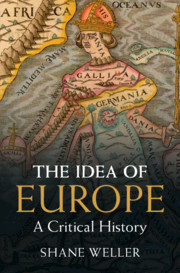Book contents
- The Idea of Europe
- The Idea of Europe
- Copyright page
- Contents
- Acknowledgments
- Introduction
- Chapter 1 Myths of Europa: From Classical Antiquity to the Enlightenment
- Chapter 2 A Great Republic of Cultivated Minds: 1712–1815
- Chapter 3 Nationalism and Universalism: 1815–1848
- Chapter 4 The Russia Question
- Chapter 5 Homo Europaeus: 1848–1918
- Chapter 6 The European Spirit: 1918–1933
- Chapter 7 A New European Order: 1933–1945
- Chapter 8 Unity in Diversity: 1945–1989
- Chapter 9 Other Europes
- Chapter 10 Europe against Itself: 1989 to the Present Day
- Conclusion Good Europeans?
- Notes
- Bibliography
- Index
Chapter 7 - A New European Order: 1933–1945
Published online by Cambridge University Press: 14 May 2021
- The Idea of Europe
- The Idea of Europe
- Copyright page
- Contents
- Acknowledgments
- Introduction
- Chapter 1 Myths of Europa: From Classical Antiquity to the Enlightenment
- Chapter 2 A Great Republic of Cultivated Minds: 1712–1815
- Chapter 3 Nationalism and Universalism: 1815–1848
- Chapter 4 The Russia Question
- Chapter 5 Homo Europaeus: 1848–1918
- Chapter 6 The European Spirit: 1918–1933
- Chapter 7 A New European Order: 1933–1945
- Chapter 8 Unity in Diversity: 1945–1989
- Chapter 9 Other Europes
- Chapter 10 Europe against Itself: 1989 to the Present Day
- Conclusion Good Europeans?
- Notes
- Bibliography
- Index
Summary
In the wake of the Wall Street Crash in 1929, Europe faced a dramatic economic downturn and mass unemployment. Visions of a peaceful cosmopolitan Europe were soon replaced by ever more extreme nationalist visions, which reached their most appalling incarnation in the racist-nationalist ideology of the Nazis. The 1930s also saw continued attempts to champion and defend a European spirit, by, among others, Julien Benda, Stefan Zweig, Thomas Mann, Joseph Roth, Edmund Husserl, and Martin Heidegger. However, the distinction between such efforts and the nationalist view of Europe grew ever weaker, and following the outbreak of the Second World War, and particularly after the German invasion of Russia in 1941, it was the Nazis who were appealing to the idea of European civilization as threatened by the Asiatic. The non-European was, for them, incarnated by the Jews and by the Russians. As Chapter 7 seeks to demonstrate, no simple opposition between the cosmopolitan and the nationalist view of Europe stands up to scrutiny, since both were rooted in ideas of Euro-supremacism and the cosmopolitan view almost always took one national culture as its model.
- Type
- Chapter
- Information
- The Idea of EuropeA Critical History, pp. 167 - 187Publisher: Cambridge University PressPrint publication year: 2021

